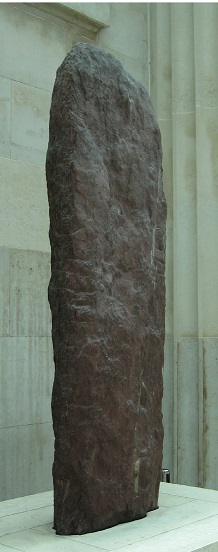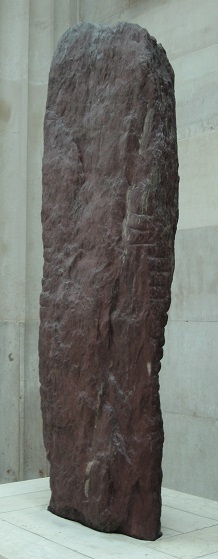Cloch na Flaitheas
The Stone of Sovereignty
The Cloch na Flaitheas (Kiltic: [klôx nə 'flɑ xəs, klɔ nə 'flaɪ xɪs], meaning Stone of Sovereignty) is a standing stone dating from antiquity which has been the coronation stone of Érevish High Kings and Emperors since ancient times. It is also called the Cloch Amhránaíochta, (Kiltic: [klôx oʊ ˌrɒ ni ˈæx tə, klɔ wŭ ˌrɒ ni ˈæx tə], meaning Singing Stone), from its legendary ability to identify the true king of Érevon by singing out at his mere touch. Among the most important symbols of Érevish identity and sovereignty, it has held a place of honor and respect among the Érevish people from the very earliest of times.
According to legend, the ancient Kiltic followers of Heremon brought the stone with them from their original homeland in Heberia with the assistance of supernatural powers. It was erected on the highest point of land on the island of Oileán Darach, where for many centuries it marked the location and served as the oath stone for all royal coronations. In the mid-second century CA it is reported to have been standing in the courtyard of the now ruined Caisleán Clochláidir, a fortified royal stronghold located on the southern end of the island. In the seventh century it was moved to the nave of the Cathedral of Saint Mogue, where it remains on public display today.
The same legends describe how it was the hero Gliúdóg who created the great scar on the face of the stone when he struck it in rage for failing to sing at his touch. It is said the stone never sang again after that day, save one time for Conn the Conqueror 500 years later.
According to legend, the ancient Kiltic followers of Heremon brought the stone with them from their original homeland in Heberia with the assistance of supernatural powers. It was erected on the highest point of land on the island of Oileán Darach, where for many centuries it marked the location and served as the oath stone for all royal coronations. In the mid-second century CA it is reported to have been standing in the courtyard of the now ruined Caisleán Clochláidir, a fortified royal stronghold located on the southern end of the island. In the seventh century it was moved to the nave of the Cathedral of Saint Mogue, where it remains on public display today.
Description
The stone is a solid slab of rough-hewn basalt1 measuring 2.37 yds. tall, .88 yrd. across and .31 yds. thick. It is a dark reddish-grey in color. Along its edges it exhibits ancient and extremely worn Ogham markings in an unknown language which have been transcribed but as yet remain untranslated. Across the front of the stone, running diagonally right to left down its entire length, is a continuous deep scar, said to have been inflicted by the sword of the mythological hero Gliúdóg himself.Mythological Origin
An Scéal Faoi Thógáil Érevonaigh (The Tale of the Taking of Érevon)2 states the stone was hewn from Omna’s bones by Tine Síoraí, the Eternal Flame, and brought to Érevon in antiquity by the gods who accompanied Heremon and the Kiltic people on their epic migration and conquest of the west.Mythical Powers
The Cloch na Flaitheas is said to possess the magical power to identify the true ruler of all Érevon and to bless him with prosperity and length of reign. According to legend, when touched by the hand of the true king the stone would sing out with joy. Conversely, when touched by the hand of a false king claiming rule over Érevon it would roar in disapproval.The same legends describe how it was the hero Gliúdóg who created the great scar on the face of the stone when he struck it in rage for failing to sing at his touch. It is said the stone never sang again after that day, save one time for Conn the Conqueror 500 years later.
Ceremonial Use
All of the high kings and emperors of Érevon from antiquity to modern times have been crowned in the presence of the Cloch na Flaitheas. In preparation for the coronation ceremony, the stone is moved from its traditional place of public display in the knave and set upon a special gold pedestal behind the coronation throne. As the new sovereign ascends the throne tradition dictates he should place his left hand upon the stone before sitting for his coronation.1 A mineral not found within 1,000 miles of Oileán Darach.
2 Preserved in Glasléad of Galney's first century history An Bunú na Ríochta (“The Founding of the Kingdom”).




Comments